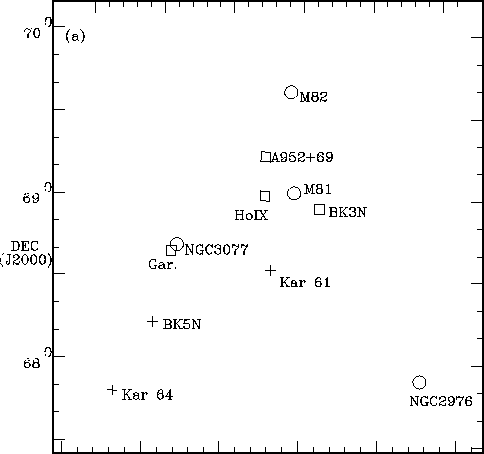
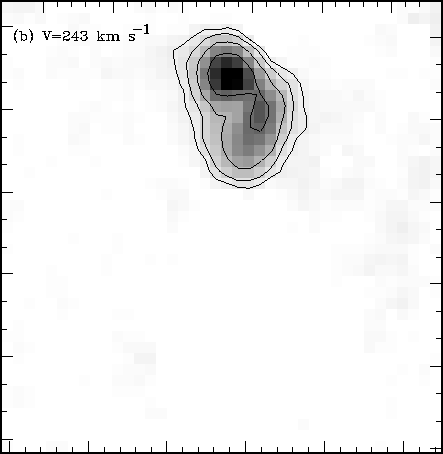
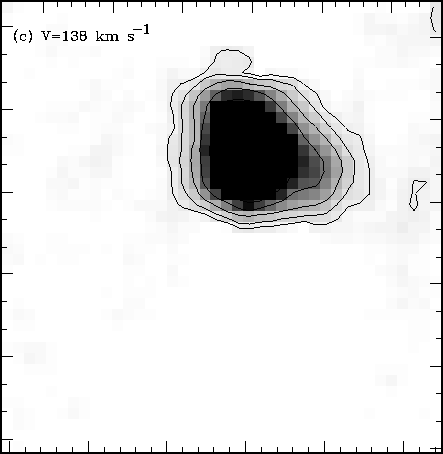
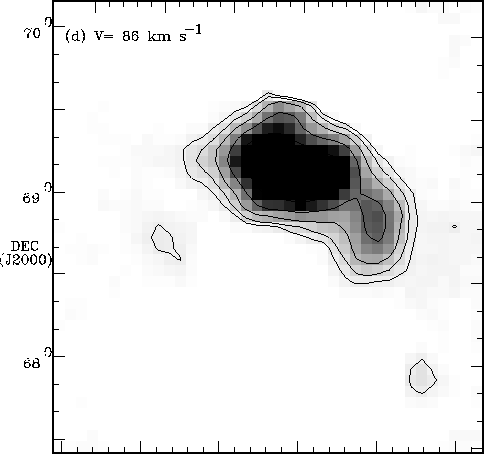
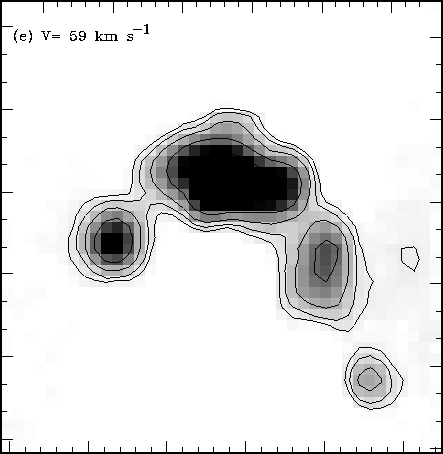
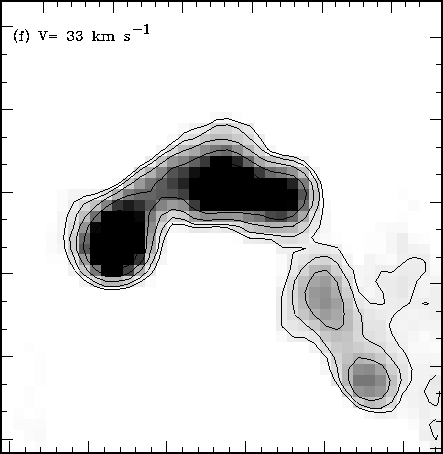
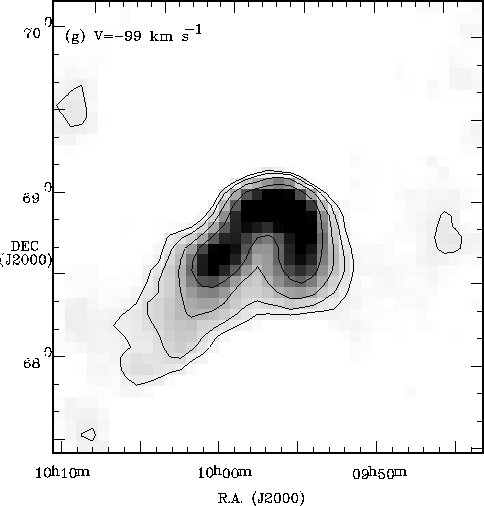
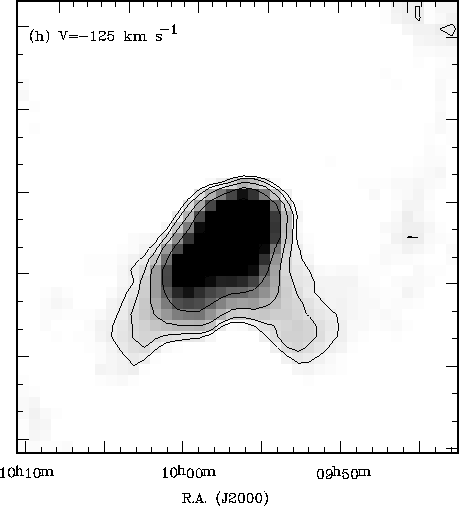
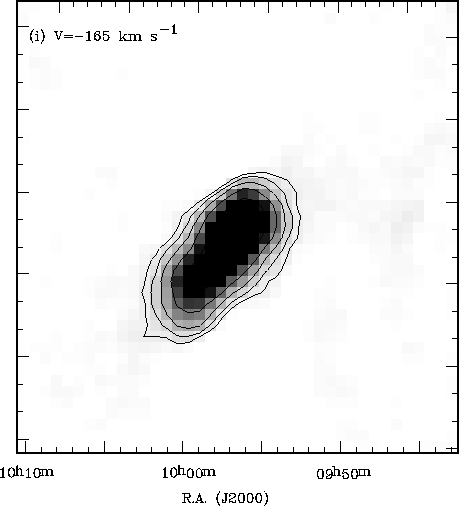
P. J. Boyce1, R. F. Minchin2, V. A. Kilborn3, M. J. Disney2, R. H. Lang2, C. A. Jordan3, M. Grossi2, A. G. Lyne3, R. J. Cohen3, I. M. Morison3 and S. Phillipps1.
[1] Astronomy Group, Department of Physics, University of Bristol, Tyndall
Avenue, Bristol, BS8 1TL
[2] University of Wales, Cardiff, Department of Physics and
Astronomy, P.O. Box 913, Cardiff CF2 3YB
[3] University of Manchester, Jodrell Bank Observatory, Macclesfield,
Cheshire, SK11 9DL
Accepted for publication in the Astrophysical Journal Letters
Abstract
1. Introduction
2. Observations and Data Reduction
3. Results
4. Discussion and Conclusions
References
Results are presented of the first blind HI survey of the M81 group of galaxies. The data were taken as part of the HI Jodrell All Sky Survey (HIJASS). The survey reveals several new aspects to the complex morphology of the HI distribution in the group. All four of the known dwarf irregular (dIrr) galaxies close to M81 can be unambiguously seen in the HIJASS data. Each forms part of the complex tidal structure in the area. We suggest that at least three of these galaxies may have formed recently from the tidal debris in which they are embedded. The structure connecting M81 to NGC2976 is revealed as a single tidal bridge of mass 2.1 x 108 Mo and projected spatial extent 80 kpc. Two spurs of HI projecting from the M81 complex to lower declinations are traced over a considerably larger spatial and velocity extent than by previous surveys. The dwarf elliptical (dE) galaxies BK5N and Kar64 lie at the spatial extremity of one of these features and appear to be associated with it. We suggest that these may be the remnants of dIrrs which have been stripped of gas and transmuted into dEs by close gravitational encounters with NGC3077. The nucleated dE galaxy Kar61 is unambiguously detected in HI for the first time and has an HI mass of approx. 108 Mo, further confirming it as a dE/dIrr transitional object. HIJASS has revealed one new possible group member, HIJASS J1021+6842. This object contains 2 x 107 Mo of HI and lies 105´ from IC2574. It has no optical counterpart on the Digital Sky Survey.
surveys - galaxies: clusters: individual (M81 group) - galaxies: dwarf - galaxies: evolution - galaxies: interactions
The M81 group of galaxies is one of the nearest groups to our own. Hence detailed study of the group may impact on many key areas of astronomy, such as structure formation, galaxy evolution, star formation and dark matter. The present catalogue of group members is the result of several optical surveys (e.g. Karachentseva et al. 1985; Karachentseva and Karachentsev 1998; Karachentsev et al. 2001). The group contains one large spiral galaxy (M81), two peculiar galaxies (M82 and NGC3077), two small spirals (NGC2976, IC2574) and a large number of dwarfs. The core galaxies of the group are strongly interacting: there is a large dynamically complex HI cloud embedding M81, M82, NGC3077 and NGC2976 (Appleton et al. 1981; Yun et al. 1994).
Several pointed HI surveys have been undertaken to search for HI in M81 group candidate dwarf galaxies (Huchtmeier and Skillman 1998; van Driel et al. 1998; Huchtmeier et al. 2000). There are about 23 dwarf members or candidate members (12 dIrrs, 9 dEs, 2 BCDs). HI has been unambiguously detected from 9 of the dIrrs and from 1 BCD. Measured velocities for M81 group objects lie in the range -140 km s-1 to +350 km s-1. Dwarf galaxies are difficult to unambiguously detect in HI within the HI complex around M81. Elsewhere, HI from group members may be masked by the strong Galactic HI emission.
In this paper we present results from the first blind HI survey of the M81 group. The data for this were taken as part of the HI Jodrell All Sky Survey (HIJASS) which is described in Section 2. Section 3 presents the observational results for the M81 group of galaxies. Section 4 discusses the results and presents our conclusions. A distance to the M81 Group of D=3.63 Mpc (Freedman et al. 1994) is assumed throughout this paper.
HIJASS is the northern counterpart to the HI Parkes All Sky Survey (HIPASS) (Staveley-Smith et al. 1996) which, when complete, will have surveyed the whole sky up to Decl.=25°. HIJASS will survey the northern sky above this declination to similar sensitivity. HIJASS is being undertaken using the Multibeam 4-beam cryogenic receiver mounted on the 76-m Lovell telescope (beam FWHM 12.0´) at Jodrell Bank. A 64 MHz bandpass with 1024 channels is used, although local interference restricts the useful velocity range to about -1000 km s-1 to +10,000 km s-1. The survey is conducted by scanning the receiver in declination strips of 8°. Each declination strip is separated by 10´, but each area of sky is scanned 8 times, resulting in a final scan separation of 1.25´. Bandpass correction and calibration are applied using the same software as HIPASS (Barnes et al. 2001). The spectra are gridded into three-dimensional 8° x 8° data cubes (R.A.,Decl.,Vo) which have an rms noise level of about 16 mJy beam-1. The FWHM velocity resolution is 18.0 km s-1; and the spatial pixel size is 4´ x 4´.
To survey the M81 group we searched the HIJASS data between Vo=±500 km s-1 in the regions 8h<R.A.<11h, +70°<Decl.<+78° and 9h03m<R.A.<10h36m, +62°<Decl.<+70°. This area (180~sq~deg) includes the whole of the HI complex around M81 and most of the outer area of the group. The HIJASS data was hanning smoothed by 3 channels. This reduces the velocity resolution to 26 km s-1 but improves the rms noise to about 11 mJy beam-1. The relatively high spatial resolution and full spatial sampling of HIJASS make it more effective at revealing dwarf galaxies within the HI complex around M81 than previous pointed surveys. HIJASS is more sensitive to low column density gas than aperture synthesis surveys.
Fig. 1 is a set of R.A.-Decl. plots of the HI emission from the HI complex around M81 at eight selected velocities.

|

|

|

|

|

|

|

|

|
| Fig. 1. R.A.-Decl. plots at selected velocity channels from hanning smoothed HIJASS data of the area around the M81 HI complex. The contours are set at 0.05, 0.1, 0.2, 0.4, 0.8, 1.6, 3.2 mJy beam-1. Fig. 1a shows the positions of known galaxies in the area (circles denote giant galaxies, squares dIrrs and crosses dEs). |
Fig. 2 is a set of Velocity-Decl. plots at five selected R.A.s.
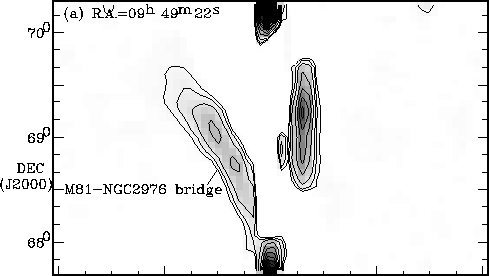
|
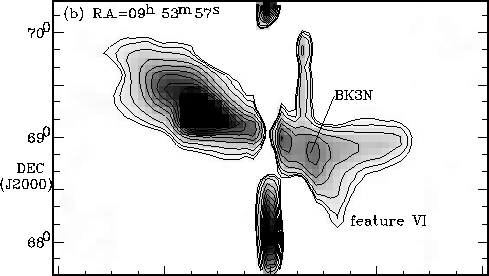
|
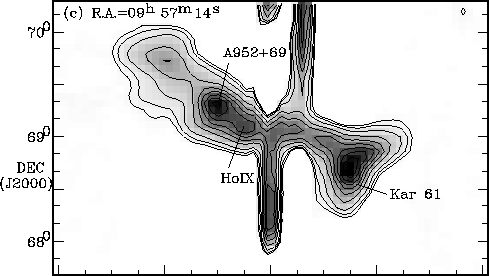
|
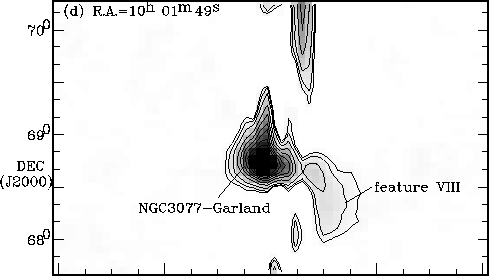
|
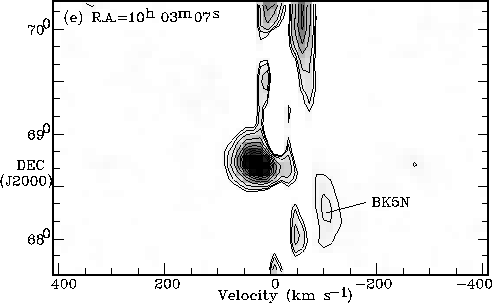
|
| Fig. 2. Velocity-Decl. plots at selected R.A.s from hanning smoothed HIJASS data of the area around the M81 HI complex. The contours are set at 0.05, 0.1, 0.2, 0.4, 0.6, 0.8, 1.0, 1.2, 1.4, 1.6 mJy beam-1. |
The tidal bridge of gas between M81 and M82 (see e.g. Appleton et al. 1981; Yun et al. 1994) can be clearly seen in the HIJASS data, for example in Fig. 1b at R.A.=9h54m, Decl.=69°30´ at Vo=243 km s-1 and in Fig. 2c stretching from Decl.=69°45´, Vo=250 km s-1 to Decl.=69°00´, Vo=0 km s-1. Within Fig. 2c can also be clearly seen the dIrr galaxies Holmberg IX (at Decl.=69°03´, Vo=50 km s-1) and A952+69 (at Decl.=69°15´, Vo=100 km s-1). A952+69 has not been unambiguously discerned in single-dish surveys (see van Driel et al. 1998) although both objects are seen in the VLA data of Yun et al. (1994) who labelled them "concentration I" (Holmberg IX) and "concentration II" (A952+69). The HIJASS data (Fig. 2c) show them to form part of the tidal bridge between M81 and M82. We suggest that both galaxies may have recently condensed from the tidal debris between M81 and M82. Morphologically such "tidal dwarf galaxies" are very similar to classical dIrrs (Weilbacher et al. 2000).
A bridge of gas apparently connecting NGC3077 and M81 can be clearly seen at R.A.=10h00m, Decl.=68°50´, Vo=33 km s-1 (Fig. 1f). Yun et al. (1994) dubbed this the "north tidal bridge" and considered it to result from a tidal interaction between M82 and NGC3077. The gas around NGC3077 is actually centred a few arcmins west of the galaxy and about 55 km s-1 higher in velocity. The dIrr galaxy Garland lies approximately at the centre of the gas. van Dreil et al. (1998) suggested that Garland may be at an intermediate stage in the conversion of a tidal tail into a dwarf galaxy.
Fig. 1 reveals a bridge of gas stretching from M81 at R.A.=09h52m Decl.=69°00´, Vo=138 km s-1, (Fig. 1c) to NGC2976 at R.A.=9h48m, Decl.=67°50´, Vo=33 km s-1 (Fig~1f). Appleton et al. (1981) considered this to consist of three linked features. However, the HIJASS data show that it forms a single tidal bridge between the galaxies (see Fig. 2a at R.A.=09h49m22s). The bridge has an HI mass of about 2.1 x 108 Mo and projected spatial extent of about 80 kpc.
The spur of HI emission labelled "feature VIII" by Appleton et al. (1981) can be traced over a much larger spatial and velocity range in the HIJASS data. Its full spatial extent can be seen in Fig. 1g (Vo=-99 km s-1) where it extends from close to NGC3077 out to R.A.=10h05m, Decl.=67°45´, a projected spatial size of about 75 kpc. The spur has a HI mass of about 3.1 x 108 Mo. The spur is strikingly seen in Fig. 2d (at R.A.=10h01m49s), stretching from Decl.=68°35´, Vo=0 km s-1 to Decl.=67°50´, Vo-100 km s-1. The apparent association of the high declination end of the spur with NGC3077-Garland is clear from this. The lower declination part of the spur continues to be seen in Fig. 2e (at R.A.=10h03m07s). The peak in the emission at Decl.=68°15´, Vo=-100 km s-1 occurs at the optical position of the dE galaxy BK5N. There is the suggestion of a second peak in the HI emission at Decl.=67°54´, Vo=-100 km s-1. This peak can be seen out to R.A.=10h05m, very close to the optical position of the nucleated dE galaxy Kar64. We suggest that the spur may result from tidal interaction between NGC3077 and either or both of BK5N and Kar64.
Kar61, the closest dE to M81 itself, can be strikingly seen in Fig. 2c (at R.A.=09h57m14s) at Decl.=68°40´, Vo=-140 km s-1. Whilst previous HI maps had shown emission at the position of this galaxy, it had not been clear whether this emission resulted from Kar61 or from M81 (see van Driel et al. 1998). Jophnson et al. (1997) found a bright HII region knot situated NE of the galaxy centre from which they measured a radial velocity of -135±30 km s-1. The correspondence of this velocity with that of the HI peak confirms that the HI is associated with this object. We estimate that at least 108 Mo of HI is associated with Kar61. On the basis of HST imaging, Karachentsev et al. (2000) suggested that Kar61 may be a dE/dIrr transition type. The presence of a large amount of HI supports this idea.
The spur of HI emission labelled "feature VI" by Appleton et al. is traced over a larger spatial and velocity extent in the HIJASS data. It can be clearly seen in Fig. 1h at R.A.=9h51m, Decl.=68°0´ at Vo=-125 km s-1 (Fig. 1h) and in Fig. 2b (at R.A.=09h53m57s) stretching out to Decl.=68°15´, V=-125 km s-1. This spur has a projected spatial extent of about 50 kpc and an HI mass of about 6.5 x 107 Mo. The dIrr galaxy BK3N appears to lie at end of this spur closest to M81. This object is best seen in Fig. 2b at Decl.=68°50´, Vo=-60 km s-1. This is the first unambiguous HI detection of this object, since previous surveys were unable to disentangle its emission from that of M81 (see van Driel et al. 1998). We estimate that about 1.8 x 107 Mo of HI is associated with the galaxy. BK3N's position at the top of the HI-spur suggests that it may be a tidal dwarf galaxy, condensing from the tidal debris of the spur. Alternatively, BK3N may be a pre-existing dIrr galaxy undergoing an interaction with M81.
There are within our survey area, but outside the M81 HI complex, a further 5 optically identified dIrr group members (Holmberg II, Kar52, UGC4483, Holmberg I, Kar73). All of these had been previously detected in HI. The HIJASS survey confirms these detections. The BCD galaxy UGC5423, which had also been previously detected in HI, is also detected by HIJASS. The other BCD (DDO82) in our survey area is not detected by HIJASS. We do not detect any of the dE galaxies which lie within our survey area but outside the M81 HI complex (i.e. Kar74, DDO71, BK6N, F8D1, KK77, FM1, KKH57).
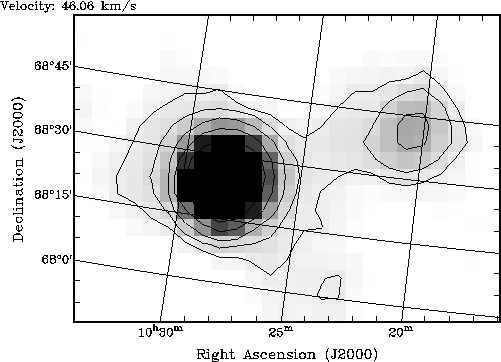
|
| Fig. 3. R.A.-Decl plot at Vo=46 km s-1 showing the HI associated with IC2574 (left) and the newly discovered object HIJASS J1021+6840. The contours are set at 0.05, 0.1, 0.2, 0.4, 0.8, 1.6, 3.2 mJy beam-1. |
An extensive search of the HIJASS data for previously unidentified M81 group members revealed only one strong candidate, HIJASS J1021+6842. Fig. 3 is a R.A.-Decl. plot at Vo=46 km s-1 showing this object. It lies about 105´ from IC2574 (projected separation 112 kpc) and there is marginal evidence for a connection to this galaxy. Its FWHM Velocity is approx. 50 km s-1 and its HI mass is about 3 x 107 Mo if it is a member of the M81 group. No optical counterpart can be seen on the 2nd generation red Digital Sky Survey. It may be a very low surface brightness dIrr companion to IC2574. We may be seeing the last remnants of a tidal encounter between IC2574 and one of the galaxies around M81.
The M81 group shows a clear morphology-density relation: dEs are found in and around the dense core close to M81, while dIrrs are spread over a much larger area. Dwarf galaxies in the Local Group exhibit a similar relation (Greber 2000). N-body simulations (Mayer et al. 2001) suggest that a close tidal interaction of a dIrr with a giant galaxy can induce severe mass loss and non-axisymmetric instabilities in the disk of the dIrr, turning it into an object which matches the observed properties of a dE. The implication is that dIrrs close to the Milky Way or M31 have been transformed in this way into the dEs now observed. Those dIrrs further away from the giants have not yet undergone a close tidal encounter and remain recognisable as dIrrs. The HIJASS data provide some evidence that a similar scenario may explain the morphological segregation of the dwarf galaxies in the M81 group.
The dEs BK5N and Kar64 appear to be associated with a tidal spur of HI mass about 3.1 x 108 Mo, stretching from NGC3077 out a projected distance of about 75 kpc. We suggest that BK5N and Kar64 may be former dIrrs which have been stripped of their gas by tidal encounters with NGC3077.
Kar61, the only dE galaxy closer to M81 than BK5N, has approx. 108 Mo of HI associated with it, shows signs of recent star formation and has been described as a dE/dIrr transition object. We suggest that Kar61 is involved in a tidal interaction with M81 but is at a much earlier stage of tidal stripping than BK5N or Kar64. We did not detect any of the dEs which lie further from M81 than Kar61, BK5N and Kar64. These dEs may already have had all of their HI stripped by previous tidal encounters.
How have the four known dIrrs within the M81 HI complex survived if other dIrrs have been tidally stripped and transmuted into dEs ? At least three of these (Holmberg IX, A952+69, Garland) may actually be tidal dwarf galaxies. The fourth, BK3N, may also be a tidal dwarf galaxy or it may be a dIrr currently being tidally stripped. The newly discovered object HIJASS J1021+6842 may be a further example of a tidal dwarf galaxy in formation, in this case one in which star formation has not yet begun.
PJB and RFM acknowledge the financial support of the UK PPARC. This research has made use of the NASA/IPAC Extragalactic Database (NED) which is operated by the Jet Propulsion Laboratory, Caltech, under agreement with the National Aeronautics and Space Administration.
Appleton, P.N., Davies, R.D., and Stephenson, R.J. 1981, MNRAS, 195, 327
Barnes, D.G., et al. 2001,
MNRAS, 322, 486
Freedman, W.L. et al. 1994, ApJ, 427, 628
Greber, E.K. 2000, in ASP Conf,
Microlensing 2000: A New Era of Microlensing Astrophysics,
ed. J.W. Menzies \& P.D. Sackett (San Francisco: ASP), in press
Huchtmeier, W.K.,
and Skillman, E.D. 1998, A&ASuppl, 127, 269
Huchtmeier, W.K., Karachentsev, I.D.,
Karachentseva, V.E., Ehle, M. 2000, A&ASuppl, 141, 469
Johnson, R.A, Lawrence, A., Terlevich, R.,
and Carter, D. 1997, MNRAS, 287, 333
Karachentseva, V.E., Karachentsev, I.D.,
Borngen, F. 1985, A&ASuppl, 60, 213
Karachentseva, V.E., and
Karachentsev, I.D. 1998, A&ASuppl, 127, 409
Karachentsev, I.D., et al. 2000,
A&A, 363, 117
Karachentsev, I.D.,
Karachentseva, V.E., Huchtmeier, W.K. 2001, A&A, 366, 428
Mayer, L., et al. 2001, ApJ, 547, L123
Staveley-Smith, L.S., et al.
1996, Publ.Astron.Soc.Australia, 13, 243
van Driel, W., Kraan-Korteweg,
R.C., Binggeli, B., Huchtmeier, W.K. 1998, A&ASuppl, 127, 397
Weilbacher, P.M., Duc, P.-A., Fritze-v.Alvensleben, U., Martin, P.,
and Fricke, K.J., 2000, A&A, 358, 819
Yun, M.S., Ho, P.T.P., Lo, K.Y. 1994,
Nature, 372, 530
| Abstract | 1. Introduction | 2. Observations and Data Reduction | 3. Results | 4. Discussion and Conclusions | References |